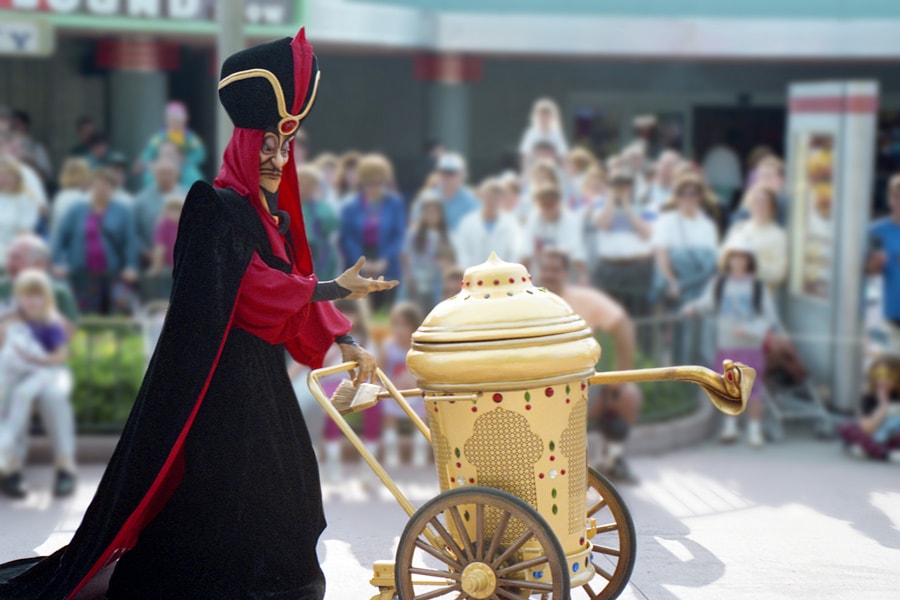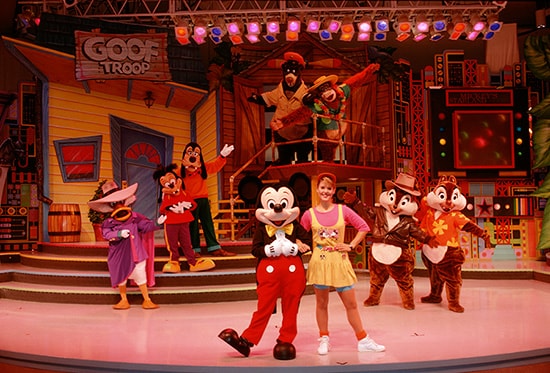1992 was a landmark year for Disney Parks, just not necessarily in the United States. Even with the focus on EuroDisney opening in April, the massive expansion Walt Disney World had seen for the last few years still had a lot of steam. Some of Disney’s most recognizable, and controversial, offerings opened in 1992.
Magic Kingdom
The Walt Disney Story closed its doors on Main Street on October 5, 1992. The lobby and display areas would still be periodically used for other purposes, but the attraction and film were no longer shown.
In Adventureland, the Tropical Serenade barker bird, originally voiced by Wally Boag, was replaced by a new bird named Artemis. La Princesa de Cristal and The Golden Galleon both closed in Caribbean Plaza and their space was merged into El Pirata Y El Perico.
In Frontierland, the original Country Bear Jamboree returned, displacing the Vacation Hoedown permanently in February. In Fantasyland, Tinker Bell Toy Shoppe became Tinker Bell’s Treasures on December 6, and Nemo’s Niche closed and was just replaced as an information booth. The Mickey’s Starland Show lost Scrooge, Launchpad and Roger Rabbit (who briefly joined the show in October 1991, along with Darkwing Duck who replaced the Gummi Bears) in favor of Goofy and Max from Goof Troop.
The biggest change to the Magic Kingdom was the addition of a massive E-Ticket in Splash Mountain. The original concept came after Dick Nunis insisted on developing a log flume attraction from Disneyland in 1983. Tony Baxter developed the concept (famously while stuck in traffic) as a way to incorporate the America Sings animatronics into a new offering. Only the Disneyland version used the recycled animatronics. Originally titled the Zip-a-Dee River Run, the name was changed at the insistence of Michael Eisner to capitalize on the popularity of the movie Splash. The original Disneyland version opened in July 1989.

Three years later, on July 17, the Magic Kingdom-version soft opened on the far west side of the park next to Big Thunder Mountain. However, the official opening was October 1, and the grand opening TV spot aired as part of the Christmas parade that year. The ride differed from the previous Disneyland version primarily by being a side by side seated ride as opposed to the original single-file seating. The ride takes guests through Chick-A-Pin hill, telling the story of Brer Rabbit escaping from Brer Fox and Brer Bear. It features three drops including the 52 foot finale into the Briar Patch. The finale scene that features animatronic figures on and around a showboat can also be seen from the Walt Disney World Railroad.

When it originally opened, guests would enter down a path right off of the bridge overlooking the final drop. Once sat in the then lap barless logs, guests would begin there journey up the mountain much as it exists today. There were minor differences: the boat with the fishing birds appears to have only had two birds originally, the second Brer Fox animatronic was originally holding an axe, and the beehive held by Brer Fox has been flipped upside down, as well as more minor cosmetic differences to costumes. The ride also featured Disney World’s first on-ride souvenir photo, which in addition to the viewing area at the end would be displayed on a TV in a box near the unload. Sadly, this never aligned with your log, meaning you always got a preview of someone else’s photo. The TV was boarded up not long after opening.
EPCOT Center
Epcot sat fairly static at this time, but the first major overhaul of the park was in the works.
At some point in 1991, some of the exhibits changed. Mexico now featured “Reign of Glory – A Celebration of Mexico’s Pre-Columbian Arts” and Norway’s Stave Church exhibit became “To The Ends Of The Earth” exhibiting artifacts from Arctic and Antarctic expeditions. Surprise in the Skies ended after a one year run on September 30.
Disney-MGM Studios
The Studios began its year with the opening of Voyage of the Little Mermaid on January 7. The waiting area originally featured a pre-show describing the artifacts in the room, including Triton’s Trident. The show began with animation, leading right into Under the Sea. Next came a laser projected King Triton instructing Sebastian to keep an eye on Ariel. After that, Ariel appears in a clamshell to sing Part of Your World after which Flotsam and Jetsam introduce Ariel to a large Ursula puppet, who sings Poor Unfortunate Souls. Much of the rest of the plot is told through an animation montage until mermaid Ariel reappears, only to transform into human Ariel on stage during a Part of Your World reprise. All the musical numbers feature a combination of animation, live action and puppetry. One of the original actresses to portray Ariel in the show, Leanza Cornett, went on to become Miss America in 1993. The Under the Sea shop opened alongside the ride.

A few other shops on Hollywood Boulevard changed some time around 1992. Pacific Electric Pictures and Sights & Sounds both went away. Pacific Electric Pictures became L.A. Prop and Storage, while Sights & Sounds was incorporated into the existing stores.
December saw a new parade, Aladdin’s Royal Caravan, debut on December 21. The parade was lead by a large inflatable Genie float, followed by the two spitting camels on a platform being “pushed” by several puppet men. Next a Gorilla float, holding a chest with the Genie sticking out of it would pass by. After that would come a two story float featuring Prince Ali’s entertainers: dancers, snake charmers and magicians. A walk around genie then let a group of dancers before Aladdin and Jasmine would appear riding the Magic Carpet atop the elephant version of Abu. Jafar followed the elephant with a “manure bucket.” Aladdin also took over the theme of the Soundstage Restaurant sometime around November/December.

The Resorts
Resort expansion slowed a bit in 1992. February 2 saw the opening of Dixie Landings, what is now Port Orleans Riverside. The Alligator Bayou section opened first, followed by Magnolia Bend not long after. This resort featured the Ol’ Man Island swimming area, Boatwright’s Dining Hall and the Colonel’s Cotton Mill Food Court. The food court stands included Southern Trace Bakery, Filé Cajun Broiler, Riverside Market & Deli, Bleu Bayou Burgers & Chicken, and Acadian Pizza n’ Pasta. The original bar was named the Cotton Co-Op, and the original marina area was the Dixie Levee.

Over at the Polynesian, Tangaroa Terrace and many of the Great Ceremonial house shops underwent minor renovations.
Over at Pleasure Island, Cage, which had replaced Videopolis East, closed in December to be replaced by the more 70’s themed “8Trax” on December 31.

The opening of EuroDisney may have slowed the growth at Walt Disney World, and the fallout from it may have changed the fate of the flagship resort for years to come, but it could not stop the snowball of growth already underway. Splash Mountain and Voyage of the Little Mermaid still exist today (aside from COVID closures). The Aladdin parade began a trend of promotional parades at the Studios. 1992 may have been the quietest year at Disney World in a long time, but it significantly shaped the resort we know today.



